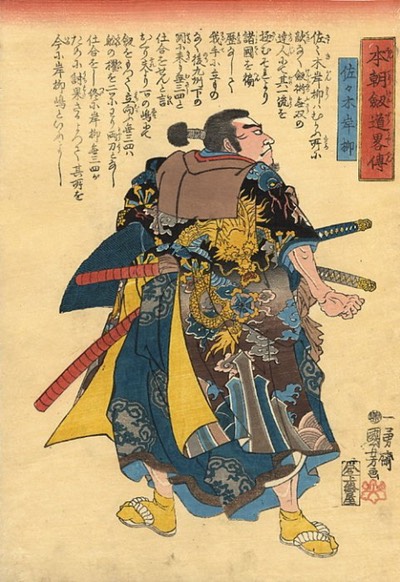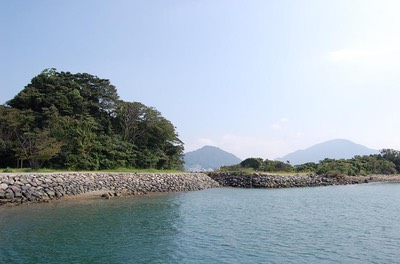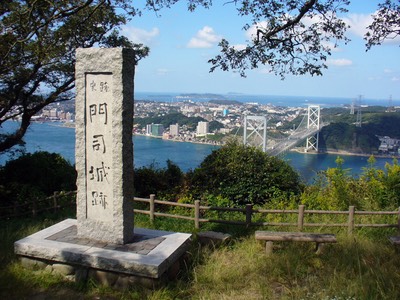The best documented and perhaps therefore most celebrated of Musashi’s many duels is undoubtedly that with the ace swordsman Sasaki Kojirō.
Kojirō was not just any wandering swordsman. At a young age he is said to have entered the service of the powerful Asakura clan, which had its headquarters in Ichijôdani castle. The Asakura were known to be great patrons of the martial arts, especially of the Toda school of fencing, which traced its ancestry way back to the legendary fifteenth-century warrior-monk Nenami Jion and his Nen school of fencing.
Chief propagator of the Toda-ryū in Kojirō's day was the famous Toda Seigen, who had under his wing a large number of aspiring swordsmen, including his star deshi Yamazaki Rokusaemon (who was later adopted by the Toda and given the name Toda Shigemasa), and Kanemaki Jisai. It was probably under Jisai that Kojirō acquired many of the Toda techniques, although, according to the Bukōden:
小次郎、幼少より勢源が打太刀を勤め、勢源は一尺五寸の木太刀を以、三尺の刀に對し、勝事を爲す。小次郎、常に三尺を以、勢源に對て粗技能あり。因て十八歳の時師の前を欠落し、自劍一流を立て、岩流と号。
From a young age Kojirō served Seigen in the role of uchidachi. Wielding a tantô of one-and-a-half feet, Seigen would win bouts against opponents with swords of three feet in length. But already at this young age, when fighting with the long sword, Kojirô was almost Seigen’s equal. And thus, at the age of eighteen, Kojirō left Seigen’s service to found his own school of swordsmanship, which he gave the name Ganryû.
Following the destruction of the Asakura clan by Oda Nobunaga’s forces in 1573 Kojiro embarked on a musha shugyô until, in 1610, in his early fifties, he became a fencing instructor to Hosokawa Tadaoki (1563–1646). The Bukōden claims that it was at this juncture that:
武公、從都來[慶長十七年壬子二十九歳]、故長岡佐渡興長の第に到て、請て曰[興長嘗武公の父無二の門弟なり]、「曾て聞、小次郎劍術奇絶なりと。庶幾我手技を比ん事を。公は家父無二ガ故あり、因て可憑て来者也。謹で願ふ、犱達せられん事を」と。
Musashi came down from the capital (in the seventeenth year of Keichō, at the age of twenty-eight) and stayed at the yashiki of Nagaoka Okinaga, who had once been a deshi to Musashi’s father, Munisai, and said to him, “I hear that Kojirō's art of swordsmanship is exceedingly rare and I would like to meet him in duel. It is only because you were once connected to my father that I now ask that you enable this contest to go forth.”
It was through Okinaga’s offices, then, that, sometime in the summer of 1612, in the first third of the hour of the Dragon (7:00–7:40), Musashi and Kojirō met in duel on the small, remote island, situated a few miles sailing to the east from Kokura in the Straits of Shimonoseki. Little more that little more than a raised sand bank, it lay on the border of Buzen and Nagato provinces, and was known variously as Funashima or Mukôjima, although today it is better known as Ganryūjima.
The various sources differ on which of the two swordsmen arrived at the island first. Whereas the Bukōden claims that Kojirō was the first to arrive at the island, the Bushû denraiki, holds that it was Musashi who first set foot on the island. Predictably, given the outcome of the bout, both scenarios are made to work in Musashi’s favor, according to the former because he causes his opponent to lose patience, according to the latter because he can dictate events. Remarkably, the Kokura hibun, on which both works seem to rely a great deal, claims that both men met on the island “at the same time.”
There are other, more pertinent differences between these two versions of events. While the Bushū denraiki claims that the event was witnessed by Hosokawa Tadaoki’s son, Tadatoshi, (then still lord of Moji castle, north of Kokura), the Bukôden only mentions Lord Tadaoki’s kenshi, or “inspectors.” No mention is made of Tadaoki’s son. Instead, it mentions that Musashi was chased off the island by Hosokawa retainers riled by the outcome of the bout. Though these may have been Kojirō's deshi, it seems unlikely since, according to the same source, Tadaoki had strictly forbidden anyone to observe or participate in the duel.
There is less disagreement on the duel itself. Both sources have Kojirô open the attack: according to the Bukōden “he struck out at Musashi’s brow, cutting the knot in the latter head towel, which fell to the ground;” according to the Bushû denraiki he attacked Musashi “by striking left and right with his two-feet-seven-inch-long Aoe sword using a mizukuruma technique, without turning his head.”
Both sources state that Musashi was fighting with a bokutō he had crafted from a wooden oar. They also confirm that his improvised weapon struck Kojirō's head, causing him to fall. Yet they differ on Musashi’s subsequent moves: The Bushū denraiki (which still refers to Musashi by his infant name of Bennosuke) claims that:
辨之助、二の目を打んと立よる所を、小次郎ふつと起あがり、両膝をしきながら、横に拂ふ。辨之助がヽるさんの前をはらりと切放て、かるさん前に垂る。辨之助、二の目を又したヽかに打つ。大力の然も舟の櫂のしたヽかなるを以て、同じつぼを二つ迄打たる故、頭碎けてひれ臥せり。
When Bennosuke moved in for the second strike Kojirō quickly rose to his knees and struck out horizontally, tearing through Bennosuke hakama. Bennosuke’s second strike, however, was a fierce one. Striking twice at the same spot with all his might the sturdy bokutô he had crafted from the oar crushed the skull and Kojirō slumped forward and lay prostate.
The Bukôden, by contrast, claims that:
武公木刀を堤て暫く立、亦振上て打たんとす。小次郎臥ながら打拂ふ。武公が褰たる袷衣の裾の膝の上に垂たる所を、三寸許剪り落す。同武公が木刀、小次良が脇の下の横骨を打折て、即ち氣絶す。
Musashi lowered his oar and stood there for some time before he raised it to strike out again. But Kojirō who was still lying down, struck out at Musashi’s legs, cutting away some three inches of the hakama he had tied up above his knees. But already Musashi’s oar had struck his opponent in the side, causing his hips to break under the impact and Kojirō to pass out.
A widely diverging—and far less heroic—version of events is given by the Numata kaki. The family records of the Numata clan, the Numata kaki was compiled in 1672 by a descendant of Numata Nobumoto, the keeper of Moji castle, situated some ten miles northwest of Kokura. Going agains most other records, it claims that:
小次郎は如兼弟子一人も不参候、武蔵弟子共参り隠れ居申候、其後に小次郎蘇生致候得共 彼弟子共参合 後にて打殺申候。
Kojirô had not brought along any deshi, as he had promised, but Musashi’s deshi had come to the island and hid themselves. Following the duel Kojirô regained consciousness, yet Musashi’s deshi ganged in on him and killed him.
Though it does confirm that Musashi won the duel, it throws a controversial light on Kojirō's death. It also is the one record to describe how, like his behavior following the Yoshioka ambush at Sagarimatsu, Musashi sought to escape the many followers of those he had slain in duel. Thus it describes how that:
依之武蔵難遁門司に遁来、延元様を偏に奉願候に付御請合被成、則城中へ被召置候に付、武蔵無恙運を開申候。
It was for this reason, in order to avoid trouble, that Musashi fled to Moji, seeking the help of master Nobumoto, who acquiesced and gave Musashi shelter at his castle, so that the latter was spared.
Any queries of remarks? Launch or join a discussion at our new FORUM


